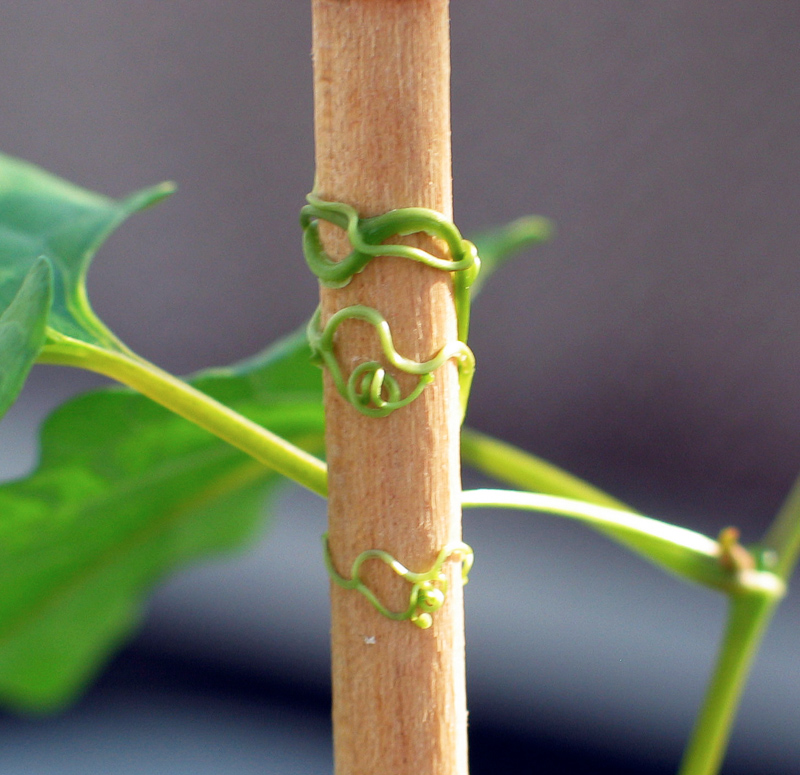BUKU BASA INGGRIS KAKAIT KARO «THIGMOTROPISM»
Temukaké kagunané saka
thigmotropism ing pilihan bibliografi iki. Buku kang kakait dening
thigmotropism lan pethikan cekak kang padha kanggo nyediyakaké panggunané ing sastra Basa Inggris.
1
Plant Tropisms: And Other Growth Movements
Darwin found that in a vertical bean root, a contact stimulus could divert the root
away from the vertical, i.e. thigmotropism overrides gravitropism; but in a
horizontal root downward curvature always occurred, even against a contact
stimulus, i.e. ...
Touchy climbers SCIENTISTS have already shown that plants have a sense of
touch, called thigmotropism. So which is more important for a climbing plant,
phototropism or thigmotropism? Recent research by Moshe Negbi of the
Department ...
3
Blue Ribbon Science Fair Projects
But another type of tropism occurs in plants — mostly vines — that must rely on
an outside support to gain height and strength. Called thigmotropism, it's the
response of a tendril when it touches a surface. Botanists have much to learn
about ...
Plants also have a touch response, called thigmotropism. If you have ever seen a
morning glory or the tendrils of a bean plant twist around a pole, then you know
that plants must be able to detect the pole. Thigmotropism works much like the ...
5
Functional Biology of Plants
Many plants respond to touch, and we will consider here thigmotropism in
tendrils. In thigmotropism, the direction of movement is determined by the surface
stimulated. Again, Charles Darwin was a pioneer in this area of research.
Martin J. Hodson, John A. Bryant, 2012
6
Introductory Botany: Plants, People, and the Environment, ...
2 Describe phototropism, gravitropism, and thigmotropism. Tropisms are
directional growth responses and are permanent. Phototropism is the directional
growth of a plant caused by light. Gravitropism is plant growth in response to the
...
Plant movement in response to light is called (a) phototropism (b) geotropism (c)
thigmotropism (d) hydrotropism 2. Plant movement in response to gravity is called
(a) phototropism (b) geotropism (c) thigmotropism (d) hydrotropism 3.
Thigmotropism: Directional Response of Plant to Touch an Object There are
some plants like bitter gourd (Karela), bottle gourd (Lauki), grape vine and pea
plant which have weak stems and hence, cannot stand upright (or erect) on their
own.
9
Cyber Science 5' 2007 Ed.
Thigmotropism is a growth response to touch. A typical example of a plant that
exhibits thigmotropism is the mimosa pudica, commonly called makahiya.
Likewise, when a vine winds around a tree, fence or trelises, it shows response to
touch.
10
Morphogenesis and Pathogenicity in Fungi
Thigmotropism is the movement or orientation of an organism or cell in relation to
the topography, shape and physical properties of the underlying substrate on
which it is growing. In both the macrobiotic and microscopic worlds, there are
many ...
José Pérez Martín, Antonio Di Pietro, 2012
BABAGAN WARTA KANG NGLEBOKAKÉ ARAN «THIGMOTROPISM»
Weruhi yèn pawarta nasional lan internasional wis ngomongaké lan kepriyé aran
thigmotropism digunakaké ing babagan warta iki.
Pest Control and Tyvek
Matt said roaches are thigmotrophic and this is a behavior called thigmotropism. This trait causes cockroaches to seek contact with solid surfaces on all sides of ... «Verde Independent, Jul 15»
Cockroach season is upon us
Matt said roaches are thigmotrophic and this is a behavior called thigmotropism. This trait causes cockroaches to seek contact with solid surfaces on all sides of ... «The Daily Courier, Jul 15»
How do vines attach to trees in the woods?
This response, known as thigmotropism, is caused by hormones that cause the side touching the stem to grow slowly, while the outside of the tendril grows faster ... «SILive.com, Mei 15»
These garden books could be the source of your green thumb
Pretty soon we'll all be throwing around words like “thigmotropism” — the ability of vines to wind their tendrils around other plants and upright structures. «The Seattle Times, Mei 15»
Crop response to length and its role in fertilizer applications
Thigmotropism: Response to mechanical touch – tendrils curl around whatever they contact. Some plants catch flies and leaves rapidly close on other plants. «Michigan State University Extension, Mar 15»
Are We Touching Each Other Enough?
Plants have been shown to grow optimally when stroked. This is called the “touch response” or thigmotropism, where we see structural changes in the roots. «PsychCentral.com, Nov 14»
How Do Plants Grow Aboard the International Space Station?
Other tropisms that can be studied are chemotropism (chemicals), thigmotropism (touch), and electrotropism (electric fields). More questions on Quora:. «Slate Magazine, Sep 14»
Lee Pennington documentary series starts Wednesday
Pennington has written 19 books, including “I Knew a Woman” and “Thigmotropism” — both Pulitzer nominees; had more than 1,300 poems published; had nine ... «The Courier-Journal, Jun 14»
What makes plants tick: Figuring out how to thrive
This sugar snap pea tendril is exhibiting thigmotropism, grasping for support in order to climb. Tony Bertauski. ×. Pete is a sugar snap pea and the smartest ... «Charleston Post Courier, Mei 14»
The 16 best Christmas books for gardeners
I was particularly interested in the short penultimate chapter, 'Botany and the Senses', about the way plants can feel (thigmotropism) and even smell each other. «Telegraph.co.uk, Nov 13»


